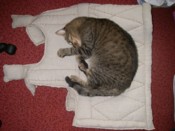Personal Equipment and Fighting Techniques Among the Anglo-Saxon Population in Northern Europe During the Early Middle Ages
de Vingo, Paolo
The Heroic Age Issue 6 Spring 2003
Abstract
The Anglo-Saxon military equipment included a sword or axe, a lance and a buckler, whereas most men would wear a dagger hanging from their belt. Despite the poor amount of evidence available, most Anglo-Saxon warriors seemed to wear helmets.
Unlike the other Germanic populations settled on the continent, the Anglo-Saxons split themselves into several kingdoms, each one with its own army. On a few occasions they allied together against the Celtic northern and western populations (Contamine 1986, 80). Gradually the kingdoms were unified. In the late seventh century, King Offa (757-796) of Mercia took the title of rex totius Anglorum patriae and had direct or indirect control over the largest part of England. Afterwards supremacy was held by the Wessex region, led by King Egbert (802-839). At the end of his reign he dominated not only southern England, but also Mercia, East-Anglia and Northumbria (Keynes 1995, 18-19). This leadership was also held under the reign of his nephew Alfred the Great (871-899), despite the Scandinavian invasion that obliged him to sign a treaty in 886; as a result, he had to leave the whole area stretching north-west of a line running from the mouth of the Thames to the mouth of the Dee (Contamine 1986, 81). His successors, Edward the Elder (899-924) and Athelsan (924-939), not only maintained the political cohesion of the English people, but they also freed them from the Danish rule. Even the consequent events, namely the episode of Canut the Great and the return of the Anglo-Saxon sovereigns with Edward the Confessor, did not break cohesion, which was reflected in the union of the King’s troops.
http://www.mun.ca/mst/heroicage/issues/6/devingo.html
Equipment and Fighting Techniques Among the Anglo-Saxon Popu
Modérateur : L'équipe des gentils modos
Grég le furet
56
Miles britto-romain an 5OO.
Letavia <a href="http://letavia.canalblog.com/" target="_blank">http://letavia.canalblog.com/</a>
56
Miles britto-romain an 5OO.
Letavia <a href="http://letavia.canalblog.com/" target="_blank">http://letavia.canalblog.com/</a>
-
thibaut de brabant
- Messages : 1271
- Enregistré le : jeu. août 06, 2009 11:00 pm
- Localisation : Lyon
Merci
"Si j'avance, suivez-moi ;
Si je meurs, vengez-moi ;
Si je recule, tuez-moi."
Henri de la Rochejaquelein
Si je meurs, vengez-moi ;
Si je recule, tuez-moi."
Henri de la Rochejaquelein

